แบบโครงสร้างทางสถาปัตยกรรมของพุทธเจดีย์ในเขตจังหวัดพระนครศรีอยุธยา The Architectural Structure Types of Buddhist Stupas in Phra Nakhon Si Ayutthaya Province
Main Article Content
Abstract
บทคัดย่อ
การศึกษาเรื่องแบบโครงสร้างทางสถาปัตยกรรมของพุทธเจดีย์ในเขตจังหวัดพระนครศรีอยุธยามีจุดหมายเพื่อศึกษาแบบโครงสร้างทางสถาปัตยกรรมและพัฒนาการทางโครงสร้างของตัวแบบพระเจดีย์ทรงปรางค์ ทรงกลม (ทรงระฆัง) และทรงย่อมุม ในพื้นที่เกาะพระนครศรีอยุธยาและปริมณฑล เขตจังหวัดพระนครศรีอยุธยา โดยให้ความสำคัญการศึกษาโครงสร้างภายในขององค์พระเจดีย์ เนื่องจากโครงสร้างดังกล่าวเป็นส่วนสำคัญที่สุดที่ประกอบขึ้นเป็นองค์พระเจดีย์และอยู่ควบคู่กับพระเจดีย์มาตั้งแต่แรกสร้าง
ผลการศึกษาพบว่า โครงสร้างของพระเจดีย์สมัยอยุธยาเกือบทั้งหมดก่อด้วยอิฐแบบสันเหลื่อม ดังนั้นขนาดวัสดุก่อและขนาดความกว้างยาวของช่องเปิดจึงเป็นปัจจัยที่สัมพันธ์กัน อันส่งผลต่อความสูงของช่องเปิดต่างๆ ทั้งช่องเปิดของซุ้มทางเข้า และความสูงช่องว่างภายในพระเจดีย์ที่ก่อกลวง
โครงสร้างส่วนต่างๆ ของพระเจดีย์สมัยอยุธยามีการก่ออิฐเป็นแบบโครงสร้างได้ 3 ลักษณะสำคัญ ได้แก่ โครงสร้างแบบก่อกลวง โครงสร้างแบบคลองราก และโครงสร้างแบบก่อทึบตัน โดยพระเจดีย์แต่ละองค์มีการใช้โครงสร้างหลักมากกว่า 2 แบบ เว้นแต่เพียงพระเจดีย์บางองค์ซึ่งก่ออิฐทึบตันทั้งองค์ ส่วนวิธีการก่อสร้างพระเจดีย์แต่ละองค์จะมีความแตกต่างกันไปตามรูปแบบโครงสร้างและขนาดขององค์พระเจดีย์
ผลการนำตัวแบบพระเจดีย์มาจัดกลุ่มพัฒนาการด้วยแบบโครงสร้างและเทคนิควิธีการก่อสร้างพบว่า สามารถจัดกลุ่มพัฒนาการของพระเจดีย์ด้วยแบบโครงสร้างได้ เมื่อนำกลุ่มพัฒนาการทางโครงสร้างดังกล่าว มาศึกษาเทียบเคียงด้านการกำหนดอายุเวลาจากพระราชพงศาวดารเท่าที่ปรากฏ พบว่ามีความสอดคล้องกัน โดยสามารถกำหนดช่วงอายุเวลาของการก่อสร้างได้ในระดับหนึ่ง อีกทั้งยังช่วยให้ข้อสันนิษฐานหรือข้อถกเถียงทางวิชาการบางอย่าง มีความมั่นคงและลดข้อขัดแย้งลงได้มากกว่าที่เป็นอยู่ในปัจจุบัน อาทิเช่น ปัญหาเกี่ยวกับพัฒนาการและการกำหนดอายุเวลา กรณีของพระเจดีย์ประธานวัดวรเชตุ เทพบำรุงและวัดใหม่ประชุมพล แต่ทั้งนี้การศึกษาดังกล่าว ปัจจุบันยังไม่สามารถชี้เฉพาะเจาะจงยุคสมัยของพระเจดีย์สมัยอยุธยาได้ทุกองค์ ทั้งนี้เนื่องด้วยข้อจำกัดด้านหลักฐานทางโบราณคดี
Abstract
The architectural structure types of buddhist stupas in Phra Nakhon Si Ayutthaya province aims to study architectural structures and structural development of prang shaped and bell shaped stupas and stupa indented corner. A structure is the most important part that firstly forms a stupa and will remain until collapsed. The study emphasize on patterns of internal structures of stupas.
This study applied a methodology history of architecture and the basic archaeological knowledge to find out objectives. The result found that Buddhist stupas during Ayutthaya period were made with bricks and formed from small mass to be a continued mass. Structure balances the force in term of compression. Stupas have a variety of symmetrical structures. Bricks were put on basement, then overlapped to the top. That wat, the heaviness balancing would be more firmly if the ground or surface was not collapsed. The way transfer force form the summit to the base is accordance with basic mechanics. Most of stupa structures during Ayutthaya period were made with bricks and corbel vault construction. Size of bricks and openings were related and affected height of openings, such as most of entrance porch and hollow space inside stupa.
Stupa structures during Ayutthaya period can be divided into 3 categories; hollow-core type, dense-core type and others (such as radius-core type and grid-core type). Each stupa at least 2 types of structure were combined to build it. For example, the basement of a stupa was built in dense-core structure while at the top a hollow-core type. However, there were some stupas which their whole structure was in dense-core type. Additionally process of stupa construction differs according to stupa size and structural type.
After stupas were grouped according to structural development and method of construction, development of stupas can be categorized according to structure. Stupa having similar structures and technique of construction can be categorized as same types. Since development of stupa structure and time period in Ayutthaya chronicle were parallel, stupa structure can be used to estimate period of stupa construction, for instance period of stupa construction at wat Worachet Thep Bamrung and at wat Mai Prachoompol. However stupa structures are not be able to signify period of construction of all stupa in Ayutthaya since there are limit of Archeological evidence.

